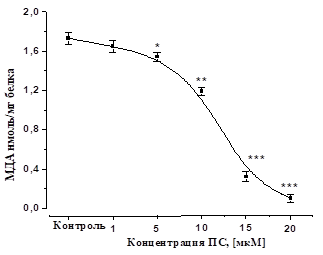STUDY OF THE FLAVONOID COMPOSITION AND BIOLOGICAL ACTIVITY OF HAWTHORN`S LEAVES CRATAEGUS PONTICA
UDC 577.1. 577.352.34
Abstract
The results of studies of the content of polyphenolic compounds and their antioxidant activity in the Pontic hawthorn plant Crataegus pontica K.Koch., growing in the mountainous regions of the Tashkent region of the Republic of Uzbekistan are presented. The collection of raw materials took place in the spring at the beginning of October 2019 and at the end of April 2020. The conditions for the isolation of polyphenolic compounds were selected under various conditions. It was shown that the optimal content of polyphenols is extracted with 70% acetone, followed by fractionation of the aqueous residue with ethyl acetate and precipitation with hexane. It was shown that in the plants harvested in spring, the amount of polyphenols was 4.28%, and the collected volume was 2.6%, of the air-dry mass of the raw material. Chromatographic methods (BC and TLC) revealed that the composition of plant leaves collected in spring contains more polyphenols than those collected in autumn. This plant contains compounds belonging to the class of flavonols, phenolic acids and flavan-3-ols. Polyphenols were identified by rutin, quercetin, quercetin-3-O-β-galactoside, catechin, and gallic acid by BC and TLC methods.
The antioxidant activity of the sum of polyphenolic compounds was studied in the model of lipid peroxidation (LPO) in rat liver mitochondria. It was found that polyphenols have a protective effect on mitochondria, a reduced damaging effect of Fe2+ / ascorbate and antioxidant activity depends on the concentration of the studied polyphenolic substances. The introduction of rutin into the incubation medium in 5 μM medium inhibits LPO processes by 32.0%, and at 10 μM – by 85.9% and in 20 μM – by 96.8%, compared with the control.
Downloads
Metrics
References
Kalikinskaya Ye. Nauka i zhizn', 2000, no. 8, pp. 90–95. (in Russ.).
Popkov V.M., Chesnokova N.P., Morrison V.V. Aktivatsiya lipoperoksidatsii – vedushchiy patogeneticheskiy faktor razvitiya tipovykh patologicheskikh protsessov i zabolevaniy razlichnoy etiologii. [Activation of lipid peroxidation is a leading pathogenetic factor in the development of typical pathological processes and diseases of various etiologies]. Moscow, 2012, 450 p. (in Russ.).
Natsional'noye informatsionnoye agentstvo Uzbekistan. Boyaryshnik poleznyy dar prirody. [National News Agency Uzbekistan. Hawthorn is a useful gift of nature]. URL: http://uza.uz/ru/society/boyaryshnik-poleznyy-dar-prirody-19-10-2017. (in Russ.).
Kurkin V.A., Morozova T.Ya., Pravdivtseva O.Ye., Zhavkina T.M., Rozno S.A. Sbornik nauchnykh trudov GNBS, 2018, vol. 146, pp. 172–174. (in Russ.).
Sokolov S.Ya. Fitoterapiya i fitofarmakologiya. [Phytotherapy and phytopharmacology]. Moscow, 2000, 976 p. (in Russ.).
Teplova V.V., Isakova Ye.P., Klyayn O.I., Dergacheva D.I., Gessler N.N., Deryabina Yu.I. Prikladnaya biokhimiya i mikrobiologiya, 2018, no. 3, pp. 215–235. (in Russ.).
ND 42-10888-00. Preparat Nastoyka boyaryshnika. [ND 42-10888-00. The drug is Tincture of hawthorn.]. (in Russ.).
ND 42-10428-99. Preparat Boyaryshnik v lekarstvennoy forme tabletki dlya rassasyvaniya. [ND 42-10428-99. The drug Hawthorn in the dosage form of a tablet for resorption]. (in Russ.).
Kurkina A.V. Khimiko-farmatsevticheskiy zhurnal, 2014, no. 12, pp. 27–30. (in Russ.).
Romanova N.G., Zelenkov V.N., Lapin A.A. Khimicheskiye osnovy ratsional'nogo ispol'zovaniya vozobnovlyayemykh prirodnykh resursov, 2010, vol. 22, no. 11, pp. 71–74. (in Russ.).
Salakhov I.A., Garmonov S.Yu. Prikladnaya khimiya i khimicheskaya tekhnologiya, 2007, no. 6, p. 22. (in Russ.).
Korenman I.M. Metody opredeleniya organicheskikh soyedineniy. [Methods for the determination of organic com-pounds]. Moscow, 1970, 343 p. (in Russ.).
Murav'yeva D.A. Farmakognoziya. [Pharmacognosy]. Moscow, 1991, 465 p. (in Russ.).
Polyudek-Fabini P., Beyrikh T. Organicheskiy analiz. [Organic analysis]. Leningrad, 1981, 624 p. (in Russ.).
Komilov E.Zh, Ergashev N.A., Tashbekova M.Kh., Eshbakova K.A., Komilov B.Zh., Asrarov M. Vestnik Gu-listanskogo Gosuniversiteta, 2016, no. 2, pp. 32–43. (in Russ.).
Gornall A.G., Bardawill C.J. American journal of Cancer Prevention, 2013, vol. 1, no. 2, pp. 14–19.
Abdulladzhanova N.G., Pirniyazov A.Zh, Mavlyanov S.M., Dalimov D.N. Konferentsiya molodykh uchenykh, posvyashchennaya pamyati akad, S.Yu. Yunusova. [Conference of young scientists dedicated to the memory of Acade-mician S.Yu. Yunusov]. Tashkent, 2003, p. 49. (in Russ.).
Mavlyanov S.M., Islambekov S.Y., Ismailov A.I., Dalimov D.N., Abdulladzhanova N.G. Chem. Nat. Comp., 2001, vol. 37 (1), pp. 1–24.
Potapovich A.I., Kostyuk V.A. Biokhimiya, 2003, vol. 68, no. 5, pp. 632–638. (in Russ.).
Utkina Ye.A. Zavisimost' antioksidantnoy aktivnosti flavonoidov ot fiziko-khimicheskikh kharakteristik v razlichnykh sistemakh: avtoref. dis. ... kand. med. nauk. [The dependence of the antioxidant activity of flavonoids on the physico-chemical characteristics in various systems: abstract of dis. ... Cand. medical sciences]. Moscow, 2005, 25 p. (in Russ.).
Schneider W.C., Hageboom G.H. Cancer Research, 1951, vol. 11(4), pp. 1–22.

Copyright (c) 2021 chemistry of plant raw material

This work is licensed under a Creative Commons Attribution 4.0 International License.

This work is licensed under a Creative Commons Attribution 4.0 International License.
The authors, which are published in this journal, agree to the following conditions:
1. Authors retain the copyright to the work and transfer to the journal the right of the first publication along with the work, at the same time licensing it under the terms of the Creative Commons Attribution License, which allows others to distribute this work with the obligatory indication of the authorship of this work and a link to the original publication in this journal .
2. The authors retain the right to enter into separate, additional contractual agreements for the non-exclusive distribution of the version of the work published by this journal (for example, to place it in the university depository or to publish it in a book), with reference to the original publication in this journal.
3. Authors are allowed to post their work on the Internet (for example, in a university repository or on their personal website) before and during the review process of this journal, as this may lead to a productive discussion, as well as more links to this published work.











